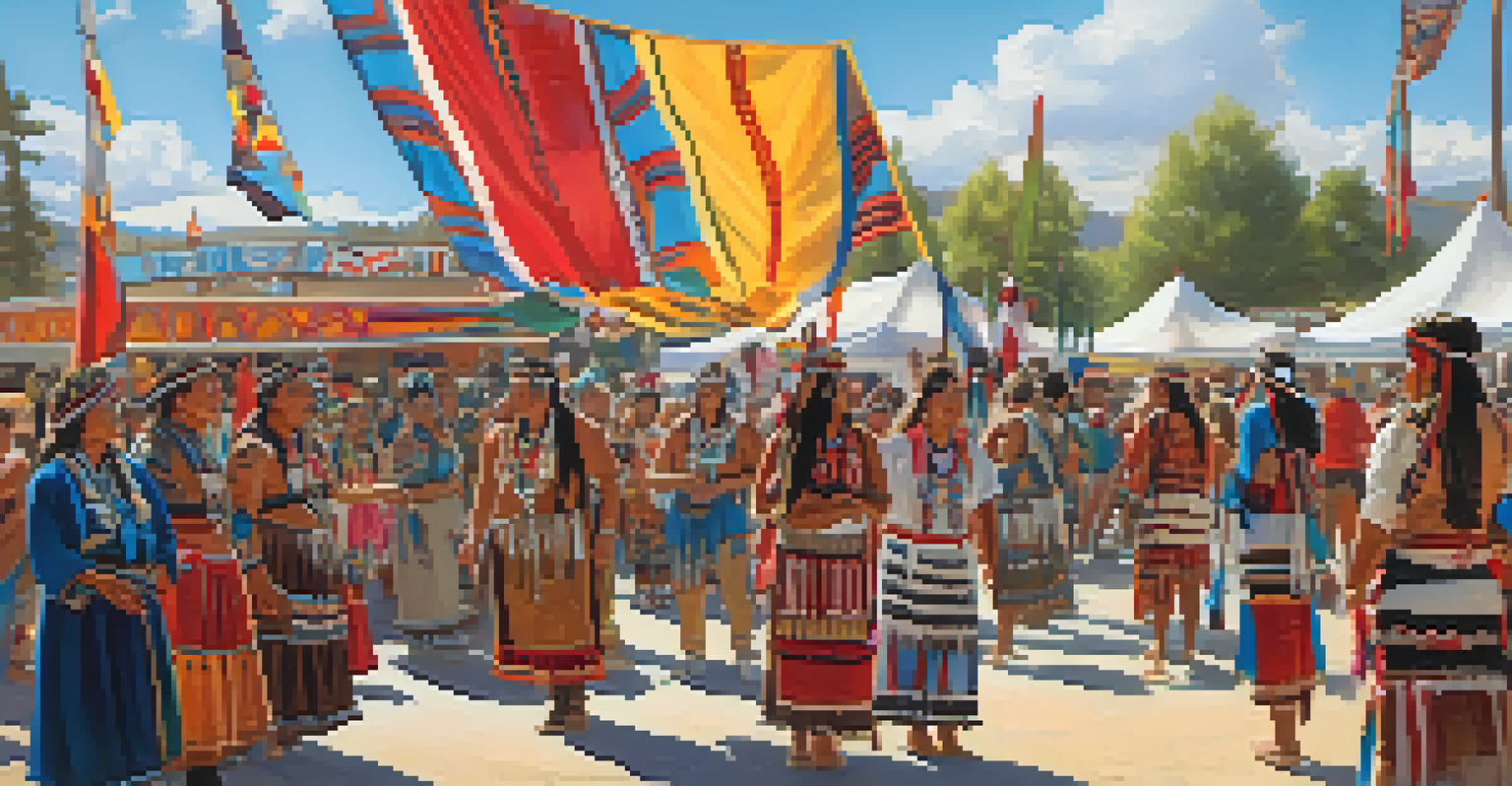The Native American Influence on Big Bear's Early Culture

The Rich History of Native American Tribes in Big Bear
Big Bear Lake, nestled in the San Bernardino Mountains, has a rich tapestry of Native American history. The area was primarily inhabited by the Serrano and Cahuilla tribes, who thrived in this mountainous region for centuries. These tribes were deeply connected to the land, utilizing its resources for food, shelter, and cultural practices. Their presence shaped not only the local ecology but also laid the groundwork for future generations.
The land is not just the ground beneath our feet; it is the foundation of our identity and the essence of our culture.
The Serrano people, known as 'the people of the pines,' relied heavily on the natural environment for their sustenance. They hunted, fished, and gathered plants, creating a harmonious relationship with the land. Similarly, the Cahuilla utilized the surrounding areas for agriculture, cultivating crops that would become staples in their diet. This connection to the land is a significant aspect of their cultural identity, influencing their way of life.
As we explore the early culture of Big Bear, it’s vital to recognize how these tribes influenced the area’s development. Their stories, traditions, and practices continue to resonate today, reminding us of the rich heritage that existed long before modern influences took hold. Understanding this history gives us a deeper appreciation for the culture that thrives in Big Bear today.
Language and Communication: A Cultural Cornerstone
Language is a vital part of any culture, and for the Native American tribes in Big Bear, it played a crucial role in their identity. The Serrano and Cahuilla languages were not just means of communication; they carried stories, traditions, and knowledge passed down through generations. This oral tradition helped preserve their history and foster a sense of community among tribe members.

For instance, many place names in and around Big Bear can trace their origins back to these indigenous languages. These names often reflect the natural landscape, showcasing the tribes' deep connection to their environment. Understanding the meaning behind these names can enrich our experience of the area and highlight the cultural significance of the land we enjoy today.
Rich Native American Heritage in Big Bear
The Serrano and Cahuilla tribes have a profound historical and cultural influence on Big Bear, shaping its identity through their deep connection to the land.
Moreover, as modern society evolves, efforts are being made to preserve these languages. Language revitalization initiatives aim to teach younger generations the importance of their linguistic heritage. This resurgence not only honors the past but also strengthens community ties and fosters a sense of pride among Native Americans today.
Traditional Practices: Connecting with Nature
The traditional practices of the Native American tribes in Big Bear are rooted in their profound respect for nature. These practices included hunting, fishing, and gathering, all conducted in a sustainable manner that ensured the land’s resources were preserved for future generations. Such an understanding of nature’s cycles reflects a deep wisdom that modern society often overlooks.
In every walk with nature, one receives far more than he seeks.
One notable practice was the ceremonial use of plants, which played a significant role in their spiritual life. For example, sage was often used in purification rituals, promoting healing and protection. These practices not only served practical purposes but also reinforced their connection to the spiritual world, emphasizing the importance of balance between the physical and spiritual realms.
As we reflect on these traditions, it’s clear that the Native American influence on Big Bear extends beyond mere survival. Their holistic approach to life teaches us valuable lessons about sustainability and respect for the environment. By embracing these principles, we can foster a more harmonious relationship with the natural world around us.
Art and Craftsmanship: A Reflection of Culture
Art and craftsmanship among the Native American tribes in Big Bear were expressions of their cultural identity. From intricate basket weaving to beautifully crafted pottery, these art forms were not only functional but also held significant cultural meaning. Each piece often told a story or represented a particular aspect of their life and beliefs.
For example, the Serrano people were known for their skill in basketry, using natural materials like willow and grass. These baskets were often adorned with intricate designs that reflected their connection to the earth and their surroundings. Such craftsmanship not only showcased their artistic abilities but also served practical purposes, demonstrating an intimate understanding of the materials at hand.
Language as Cultural Identity
The languages of the Serrano and Cahuilla tribes carry significant cultural stories and traditions, emphasizing the importance of language preservation for future generations.
Today, the influence of these traditional art forms can still be seen in the works of contemporary artists inspired by Native American culture. By recognizing and celebrating this artistry, we honor the traditions of the past while also encouraging a dialogue about cultural appreciation and preservation in our modern world.
Spiritual Beliefs: The Heart of Native American Culture
Spirituality is a cornerstone of Native American culture, and the tribes in Big Bear held beliefs that intertwined deeply with their daily lives. They viewed the world as a living entity, filled with spirits that required respect and reverence. This worldview shaped their rituals, ceremonies, and interactions with nature, fostering a profound sense of connection to their surroundings.
For instance, many ceremonies were held to honor the changing seasons, ensuring a bountiful harvest and a harmonious relationship with nature. These rituals often included songs, dances, and offerings, creating a communal atmosphere that strengthened bonds among tribe members. Such practices emphasized the importance of gratitude and respect for the earth’s gifts.
Understanding these spiritual beliefs offers a glimpse into the values that guided the Native American tribes in Big Bear. They remind us of the significance of community, gratitude, and respect for the environment, values that resonate strongly in today's discussions about sustainability and cultural preservation.
The Impact of European Settlement on Native Cultures
The arrival of European settlers in the 19th century marked a significant turning point for the Native American tribes in Big Bear. This period brought dramatic changes, including the disruption of traditional ways of life and the introduction of new social dynamics. European settlement often led to conflict over land and resources, forcing tribes to adapt rapidly to survive.
As settlers moved into the area, many Native Americans were displaced from their ancestral lands, which had been home for centuries. This loss was not just physical; it also represented a severing of their connection to the land and a threat to their cultural identity. The impact of colonization was profound, leading to the erosion of traditional practices and languages.
Resilience of Modern Native Communities
Contemporary Native American communities in Big Bear are actively preserving their cultural heritage through events and educational programs, ensuring their traditions continue to thrive.
However, despite these challenges, many Native American communities have shown remarkable resilience. Efforts to reclaim and revitalize their cultural heritage are ongoing, emphasizing the importance of preserving their history and traditions. Acknowledging this impact is crucial to understanding the complex narrative of Big Bear's cultural landscape.
Modern-Day Native American Communities in Big Bear
Today, the legacy of Native American tribes continues to thrive in and around Big Bear. Modern communities are actively working to preserve their culture, language, and traditions, ensuring that the voices of their ancestors are not forgotten. Cultural events, festivals, and educational programs are part of this ongoing effort to celebrate their heritage.
Many Native Americans in the region engage in storytelling, art, and educational outreach, sharing their rich history with both locals and visitors. These activities foster a greater understanding of their culture and encourage appreciation for the diverse tapestry that makes up Big Bear's community. By participating in these events, people can learn directly from those who carry on these traditions.

As we reflect on the influence of Native American culture in Big Bear, it’s essential to recognize the ongoing journey of these communities. Their resilience and commitment to preserving their heritage are vital to the region's identity and serve as a reminder of the importance of honoring and respecting the cultures that enrich our lives today.